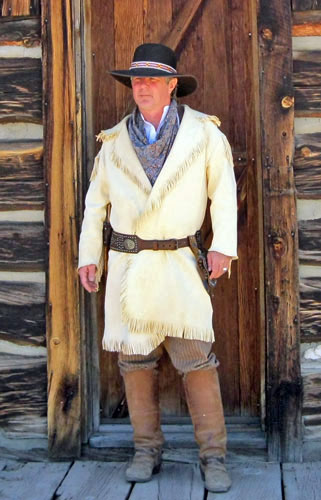Handmade Buckskin Apparel
Old Trading Post also offers Handmade Native American and Frontiersman Buckskin Apparel and Outerwear available in Elk Hide, Deer Hide, Moose Hide, American Bison Buffalo Hide and Cow Hide as well as other exotic Hides. Our Native American and Frontiersman Handmade Buckskin Apparel and Outerwear come from various American Craftsman and Craftswomen sometimes utilizing many Individuals to create a one of a kind or replicated piece of Apparel. No matter what you order you will receive the absolute finest in Hides and Workmanship with every item offered is a Satisfaction Guarantee !!
Buckskins Clothing, usually consists of a jacket and leggings, made from buckskin, a soft suede leather from the hide of deer. Buckskins are often trimmed with a fringe – originally a functional detail, to allow the garment to shed rain, and to dry faster when wet because the fringe acted as a series of wicks to disperse the water – or quills. Buckskins derive from deerskin clothing worn by Native Americans. They were popular with mountain men and other frontiersmen for their warmth and durability. Buckskin jackets, often dyed and elaborately detailed, are a staple of western wear and were a brief fad in the 1970s. The American jacket/tunic known as a wamus was originally made from buckskin with fringe.
American Bison Buffalo Clothing: A buffalo coat is a heavy winter garment made from the bison, which also commonly known as the "buffalo" (though not closely related to African or Asian buffaloes). In North America they descended from the simpler, sleeveless buffalo robes worn by the Indigenous peoples of North America prior to their partial replacement by capotes made of point blankets during the North American fur trade. Similar garments were also used across Eurasia prior to the gradual displacement and near-extinction of the European bison or wisent. Commercially produced coats with sleeves and buttons became popular with non-indigenous people during the early settlement period of the American West and the Canadian prairies. Their use mostly ended because of a rising conservationist movement intended to preserve the bison, which had been hunted to near-extinction in North America as well.
Buffalo coats were issued to police and military officers, particularly the Royal Canadian Mounted Police and the United States Army, prior to their replacement by parkas. The coats were intended for use in extreme cold or arctic conditions. The RCMP (and other Canadian police services) briefly revived them in the 1930s when 700 hides were donated by the Canadian parks service. Guards on Parliament Hill continued to wear them until 1961. With the growing numbers of farmed bison being raised since the 1990s, buffalo coats are once again available, though they are much more expensive and many times heavier than modern winter wear made of man made fabrics.

